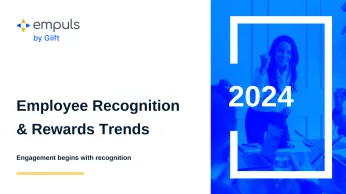Sur cette page
- But what does organizational vision mean?
- Vous avez commencé par le pourquoi : Commencez maintenant à partager la vision de l'organisation
- Un objectif, c'est bien. Un objectif partagé, super.
- Plus que de la psychologie populaire : C'est de la science.
- Pourquoi commander et contrôler, quand on peut collaborer et co-ingénier ?
- Avantages du partage de la rame
- Exemples d'engagement des employés stimulés par une vision commune
- How to engage employees by sharing organizational vision with them?
- How Empuls helps organizations sustain and share their vision
Pour engager véritablement les gens au travail, vous devez PARTAGER avec eux votre vision de l'organisation.
"Peu de forces, voire aucune, dans les affaires humaines sont aussi puissantes qu'une vision partagée." - Peter M Senge, auteur de " La cinquième discipline : l'art et la pratique de l'organisation apprenante ".
Lorsque Dunkin Donuts a déclaré : "Nous préparons de délicieux cafés dans des magasins bien gérés", dans sa déclaration d'intention, les clients ont pris note. En revanche, lorsque Coke a décrit sa mission comme "Rafraîchir le monde", nous nous sommes arrêtés, avons souri et avons tendu la main pour une bouteille.
Ce que Coke a fait, c'est ajouter le NOUS au ME. Elle n'a pas dit qu'elle fabriquait des boissons au cola (ce qui est, bien sûr, sa principale activité). Elle a insisté sur le fait qu'elle voulait que vous et moi soyons revigorés à chaque expérience. Et la pensée s'est connectée instantanément parce que c'est exactement ce que vous et moi voulons à la fin de la journée : Une gorgée qui fait disparaître la fatigue.
Ce qui précède est peut-être une dynamique marque-consommateur, mais elle se manifeste avec le même enthousiasme lorsque les deux parties de l'équation sont (A) l'entreprise et (B) les employés.
But what does organizational vision mean?
An organizational vision is a clear and inspiring statement that defines what an organization ultimately wants to achieve or become in the future. It reflects the long-term aspirations and purpose of the company, serving as a guiding light for decision-making, strategy, and culture.
A strong vision aligns employees toward a common goal, motivates them to contribute meaningfully, and helps leadership steer the organization through change and uncertainty. It’s not just a statement on a wall—it’s a shared belief that fuels collective action.
Vous avez commencé par le pourquoi : Commencez maintenant à partager la vision de l'organisation
Organizational vision needs to ultimately lead to engaged employees. What is Employee Engagement? Well, the term has been variously defined. Employee engagement can be explained as the level of attachment an employee feels towards an organization and its goals.
Notez qu'il ne s'agit pas toujours de la même chose que la satisfaction ou le bonheur des employés, même s'il s'agit d'indicateurs importants. Prendre le temps de s'assurer que vos employés sont engagés n'est pas seulement une "bonne chose pour les RH", c'est une bonne chose pour les affaires.
According to Towers Perrin's research, companies that boasted an engaged workforce pocketed 6% higher profits. A research by Kenexa, businesses with an engaged workforce fetch 5X stakeholder returns over a 5 year period.
We have discussed the importance of starting with the purpose to engage workers in an earlier article. As it turns out though, having a powerful WHY is only the first step.
For you to have a workforce that’s genuinely engaged, motivated, and fulfilled, your organizational WHY must align closely with your workers’ WHY: The reason that makes each of your team members get up in the morning and head to work.
Un employé désengagé a de fortes chances de trouver son travail "ennuyeux" et de ne pas être performant, alors qu'un employé engagé ayant une vision partagée et alignée produit des résultats positifs et accrus.
Several studies were conducted where employee groups were tasked with a job that would result in a reward. At some point during the experiment, performance dropped dramatically even when the incentive level was cranked up.
Bien que déconcertant à première vue, le raisonnement qui déclenche ce comportement est profondément simple. Chaque fois qu'une tâche, attribuée au hasard, s'avère être "ennuyeuse". Avec une motivation nulle pour le travail, l'efficacité s'effondre.
Un objectif, c'est bien. Un objectif partagé, super.
A Mercer | Sirota research indicates that ‘achieving something meaningful’ is one of the main pillars of employee engagement. The underlying reason for this observation was not just noble for the organization but also selfish for the employees. Nobody wants to be spending their life striving for something meaningless to themselves.
Le désir inné de "co-créer" un projet significatif - est important pour les êtres humains. Si les dirigeants sentent un manque de dynamisme chez leurs employés, c'est un message pour eux de revoir leur propre approche et d'ajuster leurs voiles.
Par exemple, même l'emblématique président américain George Washington recherchait activement le soutien de ses pairs et de ses compatriotes pour ses projets audacieux. Le magnat du divertissement Walt Disney a bâti un empire en acceptant gracieusement les commentaires. Plus près de nous, la communication (avec les parties prenantes internes et externes) claire et fréquente est l'un des piliers du style de leadership de Jeff Bezos.
“Certainly a leader needs a clear vision of the organization and where it is going, but a vision is of little value unless it is shared in a way, so as to generate enthusiasm and commitment. Leadership and communication (of purpose) are inseparable.”- Claude Taylor
Plus que de la psychologie populaire : C'est de la science.
Le but est sous-tendu par une solide science du comportement. Partager une vision conduit à la création d'une synergie - un outil puissant qui permet non seulement de faire fonctionner les choses, mais aussi de le faire en consommant moins de temps, d'énergie et de ressources (sans sacrifier la qualité ou la quantité du résultat). Il est profondément codé pour dissoudre les différences, relier les points invisibles et "trouver" des voies communes pour aller de l'avant.
“Synergy is better than my way or your way. It’s our way.”- Stephan Covey
An ecosystem that is synergistic at heart is able to absorb the turmoil of transition and breed new competencies into the system to make it more resilient and responsive. It doesn’t just convert current prospects but opens new doors of opportunity.
Pourquoi commander et contrôler, quand on peut collaborer et co-ingénier ?
A stark ‘collaborate and co-engineer was demonstrated by Marc Benioff, CEO of Salesforce.com. He threw his leadership team session ‘virtually open’ for all employees to attend it from anywhere they want. On that day, he didn’t just share a screen, he shared a future.
L'objectif bat le manuel, presque à chaque fois.
General Stanley McChrystal, in his book Team of Teams, argues that teams adapt more easily and respond with greater agility when harmonized by a common passion. This can be a priceless trait to have in times of rapid, technology-driven change. A shared journey acts as a compass, focussing all ideas and energies towards achieving the end in the smartest possible way.
"La rapidité et l'indépendance de notre environnement actuel signifient que ce que nous ne pouvons pas savoir s'est développé encore plus vite que ce que nous pouvons." - Stanley McChrystal, L'équipe des équipes
Lorsque vous n'avez pas de manuel ou de précédent sur lequel vous appuyer, une heuristique est votre seul recours pour prendre des décisions en temps réel. Lorsque vous n'êtes pas sûr de la "bonne" mesure à prendre, une aspiration commune facilite les choses. Tout ce que vous avez à demander, c'est : "Est-ce que ce sera bon pour l'équipe ?"
Avantages du partage de la rame
Le partage d'une vision apporte à l'équipe plus que la cohésion. Lorsque les employés sont réellement engagés - c'est-à-dire motivés dans leur rôle et fiers de leur travail - ils deviennent autonomes et apportent une contribution précieuse à l'évolution de l'organisation.
Ils se doteront instinctivement des compétences optimales, aligneront leurs capacités sur les objectifs, réfléchiront aux meilleures façons d'avancer, improviseront pour éliminer les goulots d'étranglement et fonctionneront avec une supervision minimale pour garantir la réalisation des indicateurs clés de performance. Vous trouverez ci-dessous la liste des avantages d'un objectif commun :
- Un écosystème soudé, motivé, positif et axé sur les résultats.
- Des équipes qui s'alignent, s'évaluent et se corrigent elles-mêmes.
- Importantes économies sur les coûts de formation et d'orientation (auto-perfectionnement).
- Mise en œuvre plus rapide de la stratégie grâce à l'alignement des objectifs.
- Base de connaissances robuste et dynamique (apprentissages continuellement partagés).
- Une culture naturellement innovante.
- Prise de décision biologique.
- Des performances accrues grâce à une meilleure efficacité.
- Des équipes stables avec un faible taux d'attrition.
- Meilleur équilibre entre la vie professionnelle et la vie privée des employés
Exemples d'engagement des employés stimulés par une vision commune
Let’s decode a few examples of the greater good.
1. Le projet Manhattan
La ferveur était palpable pendant le projet Manhattan, lorsqu'un groupe de spécialistes éparpillés dans l'atlas est parvenu à maintenir le secret le plus absolu sur la réalisation de leur programme nucléaire hautement secret (destiné à retarder la progression inexorable des Allemands) pendant la Seconde Guerre mondiale. Bien que séparés les uns des autres par des kilomètres, la volonté commune de repousser un ennemi commun a agi comme un puissant ciment, garantissant le succès du projet collectif.
2. Les frères Wright
L'énergie était électrique lorsque les frères Wright (et leur équipe hétéroclite) ont travaillé sans relâche pour construire une machine capable de "voler". Leur "rival" Samuel Pierpont Langley - l'éminent influenceur social de l'époque - a échoué dans sa mission de construire le premier avion du monde, alors qu'il disposait de ressources abondantes. La différence ? Langley recherchait la gloire et l'argent, tandis que chaque membre de l'équipe Wright était animé par une motivation totalement différente : Ils voulaient changer le cours de l'histoire.
"Si nous travaillions tous en partant du principe que ce qui est accepté comme vrai est vraiment vrai, il y aurait peu d'espoir de progrès."- Orville Wright
La façon dont l'univers Marvel a élargi de manière transparente sa galaxie narrative et la façon dont Wikipédia s'est transformée en une gigantesque banque de connaissances interactive sont d'autres exemples de cette synergie. Ce sont autant de rappels qui donnent la chair de poule du genre de merveilles qui sont possibles lorsque la conviction et la volonté coulent dans les veines de plusieurs personnes, et non d'une seule.
How to engage employees by sharing organizational vision with them?
L'une des façons d'avancer pour les dirigeants est d'expliquer leur vision honnêtement et clairement à la base pour inspirer les gens. La conscience (ou le manque de conscience) est à l'origine de plus de problèmes dans le monde que nous ne le pensons.
Il est parfaitement possible qu'une meilleure familiarisation avec la nécessité, l'urgence et l'impact (à court et à long terme) d'un certain objectif organisationnel génère de l'enthousiasme et du soutien pour une idée qui était initialement accueillie avec indifférence. Vous devez traduire votre vision en mots qui font sens. Malheureusement, les données nous indiquent que la communication efficace est un domaine dans lequel la plupart des dirigeants ont des difficultés.
In a Weisman Success Resource study 70% of leaders attribute their team’s performance achievements as well as issues to their own communication effectiveness
Voici les autres étapes qui permettront à votre feuille de route commune d'atteindre le tarmac avec un minimum d'agitation :
1. Unifiez votre clan
Une vision partagée peut commencer de manière dispersée. Quelqu'un doit prendre la responsabilité de rassembler les pièces du puzzle. Dans le monde des affaires, le rôle unificateur est généralement joué par les dirigeants, car ils ont facilement accès aux services inter-organisationnels, mais il existe de nombreuses exceptions.
N'oubliez pas que cela ne doit pas toujours se passer entre les quatre murs de l'organisation : Les clubs, les forums sectoriels et même les voisinages partagés sont des lieux parfaits pour que les connecteurs puissent exercer leur magie.
Empuls communities can be an effective tool to create such forums.
2. Engager la périphérie
Les dirigeants doivent également s'assurer qu'ils ne laissent personne de côté - indépendamment de la hiérarchie, de l'âge ou de l'origine. Cela est particulièrement vrai dans les cultures qui pratiquent activement la diversité.
Laissés à eux-mêmes, les humains ont tendance à se regrouper en fonction de leurs plumes, et c'est au leader collaboratif de les stimuler et de les faire sortir de leur coquille.
Assurer une représentation équitable - sans cela, le partage de la vision est un mythe. Et l'engagement, plutôt une illusion.
3. Préparer le terrain
Deploy systems and contexts that expedite teamwork while engaging with purpose. (Such as mapping effort with impact, an environment of transferable skill sets, horizontal leadership, opportunities for collaboration, avenues to learn and grow, a culture of constructive criticism, and sufficient bonding time.) Additionally, nurture a ‘comfort zone’ of trust, and stay patient.
Cela peut commencer par des petits pas, mais lorsque les employés voient que leurs pensées sont relayées dans une ambiance de soutien - en particulier dans les micro-moments quotidiens - les membres de l'équipe se sentiront en confiance pour commencer à s'engager de leur côté.
4. Perdre la laisse
To create a workplace that is truly collaborative in spirit, you must be ready to sacrifice control - sometimes to an extent that makes you queasy and uncomfortable. This can call for de-simplifying workflows, re-designing organizational structure, and re-imagining talent strategies, so are prepared for a makeover. Communication and collaboration tools like Empuls can be useful to this effect.
How Empuls helps organizations sustain and share their vision
Empuls is built to support organizations in nurturing a shared vision across all levels. Through a combination of features tailored for HR and business leaders, Empuls strengthens internal communication, promotes recognition, and builds a culture of alignment and purpose.
Here’s how Empuls fits into this narrative:
1. Social intranet for continuous communication
Empuls’ social intranet creates a unified space for leaders to share the organizational vision—not just once, but consistently. Whether it’s through announcements, CEO messages, or campaign stories, employees stay connected to the “why” behind their work.
2. Personalized recognition tied to company values

By allowing peer-to-peer and leadership-driven recognition aligned with core values, Empuls reinforces actions that reflect the vision of an organisation. Recognizing employees for embodying purpose-driven behaviors helps embed the vision deeper into the culture.
3. Feedback and surveys that amplify employee voice

Empuls enables pulse surveys and continuous feedback mechanisms, giving employees a platform to shape and influence the theme towards a shared vision. This makes the vision feel less top-down and more co-owned.
4. Celebrating progress and shared milestones

With features for celebrating birthdays, work anniversaries, and goal achievements, Empuls highlights both individual and collective progress. Leaders can use these moments to link achievements back to the company’s overarching mission—driving purpose and belonging.
5. Culture and engagement analytics

Empuls gives real-time insights into engagement levels and cultural alignment, helping leaders assess whether the vision is resonating and where gaps may exist.
A fluid ‘competency ecosystem’ (as opposed to ‘teams defined by walls’) if you will - which invites a worker, whose knack and talent maps most closely to the task at hand, to contribute and co-create the next milestone for the organization.
"Si vous voulez aller vite, allez-y seul. Si vous voulez aller loin, allez-y ensemble."













